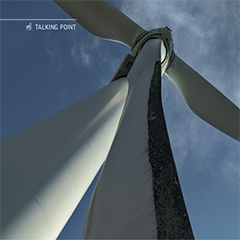The growth of wind energy is exceptional, both in terms of installations and physical size. In Europe alone, it’s predicted to overtake gas installations and become the largest form of power generation by 2020, supported firmly by a mammoth addition of 4.9GW in capacity during just the first half of 2019. Meanwhile, the size of wind turbines has reached incredible heights, with LM Wind Power unveiling the world’s longest blade at a staggering 107 meters in length (McPhee, D. 2019). Therefore, the importance of a high-quality and easy-to-apply Leading Edge Protection (LEP) coating has never been more important to keep up with the demand from this blossoming industry.
Precipitation and power generation
Although it may seem innocuous, the impact of debris and weather, particularly rain, on a blade can cause considerable damage. Using some rudimentary mathematics, the impact pressure of rain droplets can be estimated using modified water hammer equations. Based on a 2mm diameter droplet and an 80m/s tip speed, the pressure imparted by the raindrop is estimated at 120MPa. This value is already higher than the yield stress quoted for some blade materials.
This type of damage manifests itself as pitting on the blade’s surface, especially on the leading edge, where the most impact will occur. This deterioration causes a reduction in aerodynamic efficiency and subsequently a loss in operating efficiency. Some studies show that leading edge erosion can result in a drag increase of up to 500% (Sareen et al. 2014), culminating in a decrease in annual energy output of up to 20%. The effects of this damage can be apparent in as little as two years. As wind turbines can reasonably be expected to perform continuously for 15+ years, this is a significant problem for turbine operators.
A variety of studies have investigated the costs and strategies of operations and maintenance (O&M) for wind power. Some have found that these O&M ventures can account for as much as 30% of the overall per-MWh-cost for wind turbines. Other studies have looked at failures on a component-by-component basis. Depending on the type of turbine, the blades can account for up to 22% of failures. The resulting high costs means many companies are moving towards a preventative and predictive approach, especially in offshore markets.
As well as being more costly to maintain, offshore wind turbines are also more susceptible to damage. As offshore wind is not limited by acoustic emission, the tip speeds and blade lengths tend to be much larger, thereby increasing the impact velocity of the rain droplets.



























